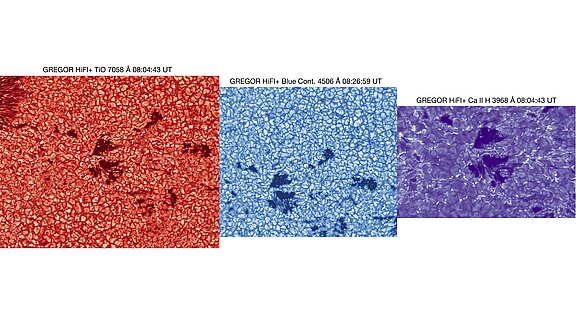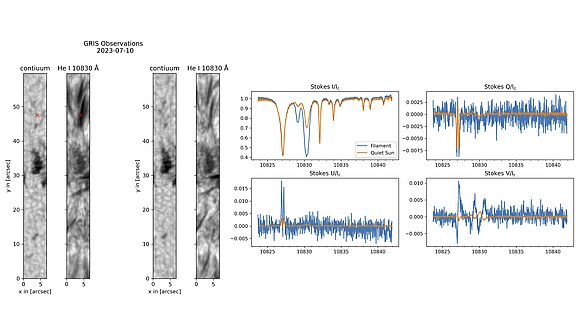First image:
"High-spatial resolution images were captured on July 10th, 2023, using the Improved High-resolution Fast Imager (HiFI+; Denker et al., 2023), which was designed and built, and is operated by the Leibniz-Institut für Astrophysik Potsdam (AIP). HiFI+ is installed at the Europe's largest solar telescope GREGOR (Schmidt et al., 2012; Kleint et al., 2020) operated by the Leibniz-Institut für Sonnenphysik (KIS) on behalf of its partners at the Observatorio del Teide, Spain. The images showcase three distinct spectral regions: TiO 7058 Å (red), Blue Continuum 4506 Å (blue), and Ca II H 3968 Å (purple) from left to right. The focus of these images is the active region NOAA 13367, revealing multiple pores and a portion of the penumbra surrounding a sunspot. The variations in the field-of-view can be attributed to the different observed spectral regions, which correspond to different layers of the solar atmosphere. Credits: Observed, reduced (sTools, Kuckein et al. 2017) and reconstructed by C. Kuckein (IAC), Assistant: Jürgen Rendtel (AIP), Speckle by KISIP (Wöger & von der Lühe 2008). (Link to high resolution image)
Second image:
"Slit-reconstructed images were captured on July 10th, 2023, using the GREGOR Infrared Spectrograph (GRIS; Collados et al., 2012) which was designed and built, and is operated by the Instituto de Astrofísica de Canarias (IAC). The instrument is deployed at the GREGOR solar telescope. GRIS, along with HiFI+, simultaneously observed the active region NOAA 13367. The spectral region observed by GRIS includes the photospheric Ca I 10839 Å and Si I 10827Å lines, as well as the chromospheric He I 10830Å triplet, among others. The left side of the image features two maps: the photospheric continuum and the upper chromospheric He I line core. In the chromosphere, filamentary structures are clearly visible, while the photosphere reveals the pores also observed by HiFI+. GRIS enables the observation of Stokes parameters and the inference of various solar properties such as the Magnetic Field, line-of-sight velocities, and temperature. Right: The four Stokes parameters (I, Q, U, and V) were observed with GRIS. The spectra shows an example of the quiet Sun (orange) and a pixel on the filament (blue), marked with a red cross on the maps. Credits: Observed and reduced by C. Kuckein (IAC), Assistant: Jürgen Rendtel (AIP)." (Link to high resoulution image)

